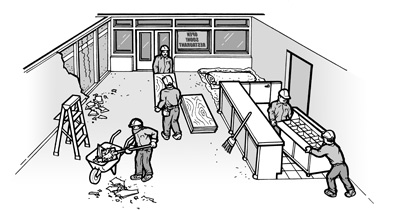



banner.jpg)


Renovating, remodeling, or altering an existing building
Businesses renovate, remodel, or alter their spaces all the time. The ADA uses the term “alteration” to mean any change to an existing building or facility that affects usability. This includes remodeling, renovation, rearrangements in structural parts, and changes or rearrangement of walls and full-height partitions. The ADA does not consider normal maintenance, reroofing, painting, wallpapering, asbestos removal, or changes to electrical and mechanical systems to be alterations unless they affect usability.

A work crew is renovating a space to make it into a small restaurant.
When passed in 1990, the ADA did not require that all existing buildings be retrofitted for accessibility immediately. Instead, it relies on planned alterations (discussed here) and barrier removal (discussed in lesson 4) to improve accessibility in older buildings over time. It says that when a business alters an existing facility in a way that affects usability, the areas or elements being altered must comply with the ADA Standards.
The standards for alterations are not always as strict as the standards for new construction. The section of the ADA Standards that discusses alterations describes many situations where less stringent provisions are allowed. In addition, the ADA recognizes that sometimes existing structural conditions cannot be modified without removing or altering a load-bearing member that is an essential part of the structure or sometimes an existing physical or site constraint prohibits modification or addition of accessible features that comply fully with the ADA Standards. In these cases, a business must comply with the provisions of the ADA Standards to the “maximum extent feasible.”
Primary function area
Any area where people carry out one or more of the major activities for which a facility is used is considered to be a “primary function area” under the ADA. For example, offices and other areas where employees work are primary function areas. The dining area of a restaurant, the meeting rooms in a conference center, the waiting room and examination rooms at a doctor’s office, the customer service area of a retail shop, and other areas where the public is served are primary function areas.
Hallways and restrooms usually are not primary function areas. Neither are mechanical rooms, boiler rooms, janitorial closets, employee lounges, locker rooms, or supply storage rooms.
When a primary function area is altered, the areas and elements being altered must, of course, comply with the ADA Standards as discussed previously. In addition, because the area being altered is a primary function area, the following requirement also applies.
The route and amenities that serve a primary function area
A core concept in determining if a building is accessible or not is the path a person travels in getting from the parking area or sidewalk into the building, to the areas where he or she works or is served as a customer, and to the restrooms and other amenities that are provided in the facility.
When a primary function area is altered, the path of travel to the altered area and the amenities serving the altered area must be made accessible, unless the costs for these changes are disproportionate. The costs for the added alterations are considered disproportionate if they exceed 20 percent of the cost of the overall alteration. In this case, you should make as many of the changes as you can without going over the 20 percent limit. Use this order of priority: entrance; route to the primary function area; at least one unisex restroom or one restroom for each sex serving the area; public telephones serving the area; drinking fountains serving the area; other elements.
Exceptions: (1) When the only features being altered in a primary function area are the windows, hardware, controls, electrical outlets, or signage, there is no requirement to make the additional improvements discussed above. (2) When simply removing barriers (as discussed in lesson 4), there is no requirement to make the additional improvements discussed above.
|
|
|
|
|
|




